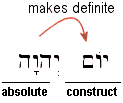|
After studying Unit Four, you should have mastered the following material:
General Properties of nouns
A noun is a name (nomen) given to an person, place, or thing. Nouns have the following properties:
- Gender (masculine or feminine)
- Number (singular, plural, or dual)
- Person (first, second, or third)
- Case (subject, object, or construct-possessive)
In general Hebrew uses endings to indicate these various properties of nouns. By learning the root (or stem) of the noun and its endings, you will begin to understand the way nouns function in Hebrew sentences.
Noun Endings
Keeping in mind that some masculine nouns take feminine plural endings (e.g., avot) and some feminine nouns take masculine plural endings (e.g., nashim), the following chart summarizes the most common noun endings encountered in Biblical Hebrew:

When endings are added to Hebrew nouns, vowel changes, accent changes, and changes in spelling may occur. Review Section 4.5 for more information.
The lexical form of a word is the spelling of the word as it appears in a dictionary. Be advised that the lexical form of a word is always the singular spelling.
IMPORTANT NOTE: Initially I was planning to include a vocabulary list for each Section of the online grammar, but upon further reflection, I have decided against doing so. The reason is technical: it simply takes too much time to make graphic images of the word lists (and, if I did do this, the pages would load slowly on your computer). For example, here is a list of a few nouns from a decent Hebrew dictionary:

At this point in your studies, you should buy either a good Hebrew-English dictionary or use a Biblical Hebrew word frequency list. I'm sorry, but re-creating such a listing for all the words in Biblical Hebrew would be an enormous project that would really be re-inventing the wheel, anyway. Besides, you will want a good Biblical Hebrew dictionary when you are reading from the Scriptures.

For beginners, the Langenscheidt's Pocket Dictionary - Hebrew to Engish - is a good value and will complement this web site nicely. Click here to order one.
The Definite Article
The basic form of the article is a Hey pointed with a patach followed by a dagesh forte in the following (non-guttural) letter:

If a noun begins with a guttural letter, then when the article is added, the patach under the Hey "compensates" and may change. Some vowel changes may also occur within the word when the article is appended (see Section 4.6 for more information).
There is no indefinite article in Hebrew and proper nouns are definite by definition.
The Conjunctive Vav
Like the definite article, the word "and" in Hebrew functions as a prefix to Hebrew words. To make a Hebrew word (of either gender) part of a connecting sequence, you add a Vav before the noun. Sometimes the vowel under the Vav changes, depending on the consonant that appears at the beginning of the word. This function of the Vav is often referred to as the "Conjunctive Vav."
The basic form of the conjunction is a Vav pointed with a simple Sheva:

When the Conjunctive Vav is prefixed to words beginning with Bet, Mem, or Pey ("BMP letters), the dagesh is lost (since the letter is now preceded by a vowel sound), and the conjuction takes the form of a Shureq.
When the Conjunctive Vav is prefixed to a guttural letter that has a reduced (chateph) vowel, the Vav will take the corresponding unreduced vowel as its vowel.
There are other vowel changes that occur with the conjunctive Vav. See Section 4.7 for more information. (There are also other uses of the Vav that will be discussed, IY'H, later in this grammar.)
The Construct Chain
When two (or more) nouns appear together (either by juxtaposition or by means of a maqqef), they are said to be in a "contruct relation" to one another.
The first noun of the pair is said to be in "construct" relationship with the following noun , which is said to be in the "absolute" state. When two nouns appear in a row like this, the relationship expressed between them is one of possession, and the first word of the pair should be translated with "of" following it.
A pair of words in the construct state is considered a single unit. Phonetically, the accent shifts away from the first noun to the absolute noun, and this loss of stress causes changes in the construct form's vowels.
You identify the construct noun in a word pair by means of endings:

Definite Nouns and Construct Chains
When the second word in the pair (the absolute noun) is definite, the entire construct is considered definite (and conversely, if the second word is indefinite, the entire pair is indefinite). In other words, the "definiteness" of the entire chain is determined by the absolute noun's state. If the noun is definite (i.e., has the definite article or is a proper noun), then the chain is definite as well.

"The day of the LORD"
Irregular Construct Forms
Finally, some construct forms are "irregular" in their spelling and must simply be memorized.

Review Section 4.8 for additional details of the Hebrew construct chain.
|







